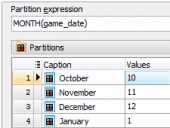PHP Generator for MySQL online Help
| Prev | Return to chapter overview | Next |
Barcode
PHP Generator for MySQL allows to represent string (CHAR, VARCHAR, BINARY, VARBINARY, BLOB, TEXT, ENUM, and SET) columns as barcodes, symbols that can be scanned electronically using laser or image-based technology. To equip you application with barcodes, you need installed PHP 7.0 or higher.

To generate barcodes, select the type of Barcode and specify Single bar width and Bar height in pixels.
This version PHP Generator for MySQL supports Barcode types:
Code 32 Code 39 Code 39 + Checksum Code 39 Extended Code 39 Extended + Checksum Code 93 Standard 2 of 5 Standard 2 of 5 + Checksum Interleaved 2 of 5 Interleaved 2 of 5 + Checksum |
Code 128 Code 128A Code 128B Code 128C EAN-2 EAN-5 EAN-8 EAN-13 UPC-A UPC-E |
MSI MSI + Checksum POSTNET PLANET IMB Codabar Code 11 One-Track Pharmacode Two-Track Pharmacode |
Bar color
Specify the color of barcodes foreground to make them visible in dark color schemes. The default bar color is black, but you can select white or specify the color in RGB format.
Align
Allows you to specify the alignment of the control. Possible values are Default, Left, Right, and Center.
Inline styles
Use this field to set formatting options to be used inside the style attribute of the element. For example, to set the font color and the background color for a control, place the following string to Inline styles:
color: red; background-color: yellow;
Custom attributes
This property allows you to add simple metadata to individual elements, largely for the purpose of providing information to make JavaScript functions easier. Such attributes can be later handled in client-side events. For example, to add several custom attributes to an editor, enter the following string into the Custom attributes edit box:
data-city="Boston" data-lang="js" data-food="Bacon"
It is recommended to prefix all custom attributes with data- to keep the result document compatible with the HTML5 requirements.
Null label
This property allows you to define how NULL values are represented for this column. By default the value of this property corresponds to the one defined at the project level. You can specify a custom value for a certain column (for example, "Not selected", "Not available" "Not supported", etc.) if necessary.
| Prev | Return to chapter overview | Next |





 Download
Download Buy
Buy

